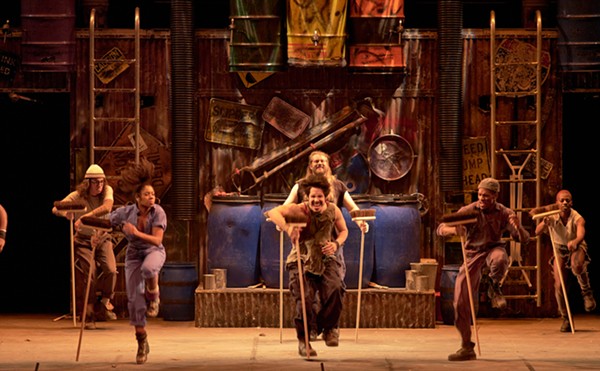Hoffman's work combines found objects and constructed materials to achieve dreamlike results. In art by Dadaists like Marcel Duchamp and Meret Oppenheim, familiar objects are placed in unusual combinations or in strange contexts. Dadaists placed urinals in art galleries and covered teacups and spoons with fur. All this was part of an attempt to liberate the unconscious; to encourage viewers to value their dreams and to respect absurdity. Hoffman's sculptures are full of familiar domestic objects and common materials that, to her, "symbolize and celebrate women" -- vases, bowls, eggs, shoes, purses, and wings. But Hoffman presents these materials in strange combinations. For example, in a quirky work titled "Vas Spiritualis," she wraps a tall pedestal with multicolored bird feathers. At the top, there's a vase with metallic wings instead of handles and a table fork pasted onto the front. Like its Dadaist precursors, it takes its own strangeness seriously and in so doing persuades you to pause and take a closer look.
Phyllis Seltzer's paintings and prints of Cleveland take a completely different approach. Initially, Seltzer's work, with its emphasis on the geometrical elegance of the city's bridges and tall buildings, and the process of steel production, evokes Margaret Bourke-White's pathbreaking 1920s photography of Cleveland industry. Bourke-White's photographs, especially the ones of Otis Steel, with its enormous smokestacks dwarfing workers standing below, have become icons of Cleveland's past. Anyone since who has dared to create art in this vein has had to contend with them. In this particular body of work, Seltzer sidesteps the issue of Cleveland's gradual decline as an industrial center. The work is nevertheless impressive for its technical expertise. Her idiosyncratic color choices (it's not unusual in a Seltzer piece to find the sky rendered in cotton-candy pink and a Hulett ore unloader in hot orange) serve to undercut the implicit nostalgia in her subject matter. Along with their boldly intuitive color combinations, her works at Wasmer exude structural rightness. There is no clutter in them.
The best pieces here are those depicting the Huletts as integral parts of the city skyline. These large-scale paintings and prints combine hard edges with flowing shapes in well-orchestrated compositions. Interestingly, the focus in this art is placed not on our revitalized downtown, but rather on the Huletts. For instance, in "Hulett Unloader," Seltzer leads our eye across the painting by means of a horizontal line that takes the form of railroad cars carrying coke. We stop (as a railroad car would stop) at the Hulett that has been placed at far right. Why has Seltzer led us past the Terminal Tower to this industrial relic? It is in such a structure that Seltzer sees Cleveland's past. We think of the vitality of steel production in the '20s, not of decay, when viewing this painting. It's a well-executed reminder of Cleveland's former status as a steel-making capital.
Also impressive are Seltzer's heat-transfer prints. These are reproductions of the paintings (by a process akin to photocopying).The colors in the prints are slightly muted, as though all the amusement-park color that the artist uses has been toned down just a few degrees. The prints also glisten when you see them up close, a curious effect that probably has something to do with the heat-transfer process. These prints demonstrate Seltzer's technical command. Furthermore, because of the subtle variations in color, one doesn't experience them as clones of the paintings, but rather as independent works.
Joan Damankos's work, meanwhile, mines the soil of memory in an altogether different way. Her sculpture puts a personal touch on politically charged environmental issues. For example, there is the work called "National Forest." It consists of a table with raised sides; in it are pieces of wood that stand on end. In the center of the table is a rusted typewriter holding a blank sheet of paper. On the floor, a roll of blank paper echoes the shape of the individual pieces of wood in the table. This melancholic work is about wood, paper, and the people who waste both. The political message is clear -- recycle and don't waste so much -- and yet the images are resonant beyond that common rallying cry. With that rusted typewriter, Damankos might be suggesting something of the struggle that great writers in the past have undergone in the process of getting their ideas down on paper.
Exhibits like this, with no organizing idea, can sometimes be a chore to view. Aside from the fact that these artists are all women, there is nothing to tie their work together. However, there is much to think about in this year's invitational, and that's to these artists' credit.












